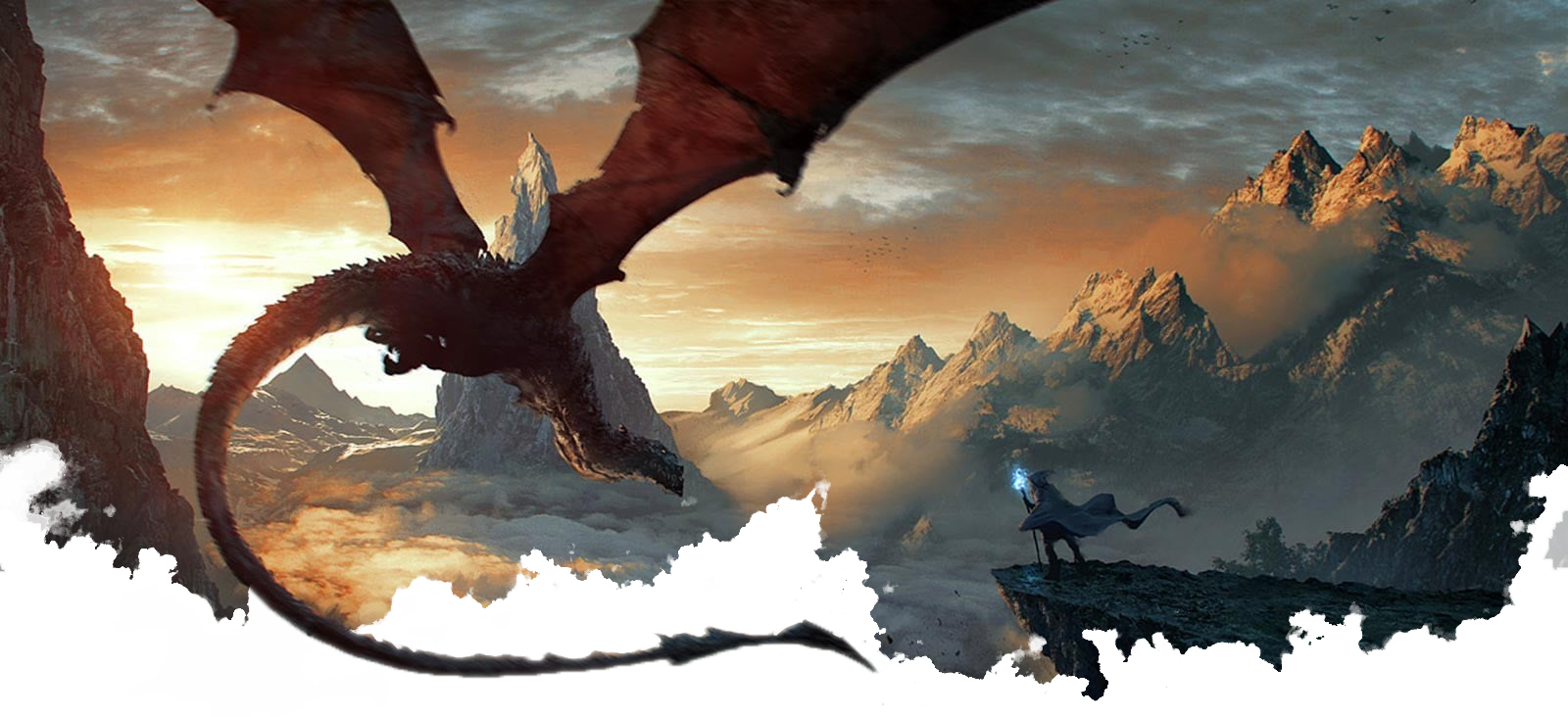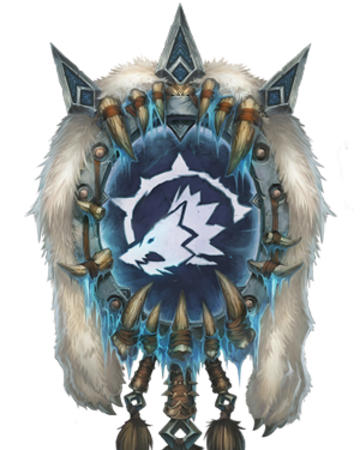The Frostwolf clan, also spelled Frost Wolf clan, is a relatively peaceful and highly spiritual
Goliath clan.
Government
The Goliath are organized in clans. Most Goliath resist submission, and will not kneel before anyone. The closest thing to leadership comes from the respect gained from other Goliath by those who have performed significant, widely recognized deeds. Those Goliath are not considered rulers of those living within the clan, but respected members that are listened for the clan's decision.
The Frostwolf government is led by a chieftain, who is chosen by the council of elders. The council of elders is made up of the most respected and experienced members of the Frostwolf clan. They are responsible for making important decisions for the clan, such as declaring war, forming alliances, and distributing resources. The chieftain acts as the leader of the council and is responsible for carrying out the council's decisions. The chieftain's rule is absolute, but he or she is also held accountable to the council of elders.
The Frostwolf clan is organized into smaller groups called packs. Each pack is led by a leader, who is responsible for the well-being of the pack members. The leader is elected by the pack members, and is responsible for making decisions for the pack and communicating with the chieftain and the council of elders. The packs are responsible for taking care of the daily needs of the clan members, such as food, shelter, and protection.
The Frostwolf government is based on a strong sense of community and cooperation. The clan members are expected to help each other, and to share resources and knowledge. The government is designed to ensure the survival and prosperity of the clan, and the council of elders is responsible for making decisions that are in the best interest of the clan as a whole.
Culture
Three virtues for the Goliath culture, independence, legend, and passion.
As a people, the Frostwolf clan values community and family above all else. They have a strong sense of togetherness and work together to support one another. They also place a strong emphasis on personal honor and integrity, and they believe in treating others with respect and fairness.
The Frostwolf clan has a rich tradition of storytelling and oral history. They use stories to pass down their history, customs, and values from one generation to the next. They also have a strong tradition of poetry and song, which is used to express emotion and commemorate important events.
Braum, the Frostwolf hero, With strength and heart of gold
He stood up for his kin, To help, young Braum was told
Through blizzards and through storms, Braum guides us through the fray
With laughter in his heart, He shows us a better way
With every step he takes, We know that we are safe
The Frostwolf clan has a strong warrior tradition, and many members of the clan are skilled fighters. They value strength and skill in battle, and they often engage in friendly competitions and training exercises to improve their abilities. The clan also places a high value on physical fitness, and many members of the clan participate in regular training and exercise to maintain their strength and agility.
Goliath culture has a focus on success and glory—particularly when gained from the hunt or in a battle. The Goliaths do not fear death, as they believe the bold and strong can achieve immortality through the tells of their deeds, but they do fear they will be weak and end up forgotten. As a result, each Goliath seeks to prove themselves, to build their legend through feats of valor and great victories.
Religion
The Frostwolf practice a shamanistic religion, holding reverence for the Spirits rather than the gods.
Each spirit has its own group of shamans. These shamans dedicate themselves to a specific spirit, serving as guardians of the sacred places where the spirit is honored and as teachers of the spirit's wisdom. Among the Frostwolf, there is a powerful shaman known as the havroun who shares a special connection with each spirit.
The Frostwolves approach their religion in an individualistic manner. Groups of Goliaths, such as families, larger lodges, or isolated homesteads, tend to venerate a particular spirit more prominently than others. They invoke the unique qualities and attributes of that spirit, aspiring to emulate its essence. As a result, certain spirits may be more widely revered in specific locations, occasionally leading to tensions between followers of different spirits. It is important to note that while Goliaths may focus on honoring one spirit above others, they recognize the existence of all the Spirits, even if they do not hold them all in high esteem or consider some to be weaker.
The Frostwolves can seek aid from the Spirits of the Wild when needed.
Although they do not worship or revere the gods, the Goliaths acknowledge their existence and acknowledge the gods' power.
Oyaminartok
Goliath legends speak of a creature that prowls the far reaches of the Ice-peak Concord terriotry, known as Oyaminartok the Winter Walker. She can take the form of either a polar bear or a hulking, bipedal shape obscured by wind and blowing snow. Elders invoke her name to keep young goliaths from wandering too far from home before they’re ready. Adult goliaths sometimes encounter this legendary individual in their travels to the far-flung corners of the north. If they flee like cowards, Oyaminartok laughs and lets them go to wander in obscurity. If they challenge Oyaminartok to a fight, the Winter Walker smiles and tests their mettle. Those who impress her with their fighting skills are blessed and become goliath werebears.
Wedding
Goliaths are known to form marriages, but such unions are only permitted between couples of equal status. During the wedding ceremony, a representative must speak on behalf of the couple to demonstrate that they are a suitable match for each other.
Interior Decoration
Interiors are often decorated with trophies from battle as well as skins and hides used as tapestries for recording their culture's history and lore.
The Frostwolf clan is known for their skill in crafting. They are particularly adept at working with ice and snow. They are also skilled at creating intricate carvings and sculptures out of ice, which are used to decorate their homes and public spaces.
Despite the harsh and cold climate of their homeland, Goliaths often prefer lighter attire, leaving their skin partially exposed. It is not uncommon to see their exposed skin adorned with intricate and elaborate tattoos.
Names
Every goliath has three names: a birth name assigned by the newborn’s mother and father, a nickname assigned by the chieftain, and the clan name. A birth name is up to three syllables long.
Birth names are rarely linked to gender. Goliaths see females and males as equal in all things, and they find societies with roles divided by gender to be puzzling or worthy of mockery. To a goliath, the person who is best at a job should be the one tasked with doing it.
A goliath’s nickname is a description that can change on the whim of a chieftain or tribal elder. It refers to a notable deed, either a success or failure, committed by the goliath. Goliaths assign and use nicknames with their friends of other races, and change them to refer to an individual’s notable deeds.
Goliaths present all three names when identifying themselves, in the order of birth name, nickname, and clan name. In casual conversation, they use their nickname.
Birth Names: Aukan, Eglath, Gae-Al, Gauthak, Ilikan, Keothi, Kuori, Lo-Kag, Manneo, Maveith, Nalla, Orilo, Paavu, Pethani, Thalai, Thotham, Uthal, Vaunea, Vimak
Nicknames: Bearkiller, Dawncaller, Fearless, Flintfinder, Horncarver, Keeneye, Lonehunter, Longleaper, Rootsmasher, Skywatcher, Steadyhand, Threadtwister, Twice-Orphaned, Twistedlimb, Warhammer, Wordpainter
Clan Names: Frostwolf
History
Goliaths claim to be descendants of giants and once ruled over the lands before their decline. They sought the aid of the Spirits to stabilize their culture.
After the
War of the Ancients, a dragon settled in the north where the Goliaths lived. The Goliaths began to worship the dragon as one of their spirits, and the dragon embraced this, exerting its influence over them. Internal conflict arose when some Goliaths refused to worship the dragon as a spirit. To avoid further strife, the Goliaths split, with those not worshipping the dragon choosing to migrate. Creating the two existing Goliath clan.
During the establishment of a new elven kingdom, the elves settled near the Goliaths. Instead of engaging in war with the towering humanoids, the elves drove away the spirits that the Goliaths revered. This compelled the Goliaths, now without their spirits, to migrate, harboring resentment towards the elves for their actions. To this day, Goliaths naturally hold a grudge against the elves, unaware of the historical reasons behind it.
They used to be part of the tribes in
Green earth, but the constant fight and lute for power wasn't to their taste. The Goliath
Frostwolf clan started to move again, looking for a place to settle.
Migration
In 436 AD, The goliath, on the move, found the Dwarves. The Frostwolf clan was rather pacifistic, they did their best not to clash with the secluded dwarves that just started to open up. 1 mutual agreement emerged, the goliath would take the frozen tundra, up north of the
Ice-peak Concord, where they would settle without bothering the Dwarves.
The goliath, nevertheless, refused to destroy or abandon the ship they lived on during this journey and decided to build their new home directly aboard of those ships.
War of the two peak
Despite their peaceful nature, the Frostwolf clan was not immune to the conflicts and wars that plagued the region. They fought bravely alongside the Dwarves during the
War of the Two Peaks and the Battle of the Glacier, earning the respect and admiration of their allies.
The War of the Three Peaks was a major conflict that occurred in 874 AD between the Frostwolf clan and the
Stormcaller Clan. The war was sparked by a dispute over territory in the northern tundra due to the greed for new territories of the Stormcaller.
The Stromcaller clan, led by their chief, sought to claim the Frostwolf's land for themselves, believing it to be rich in resources.
The war lasted for several years, with both sides suffering heavy casualties. The Frostwolf clan, being smaller and less martial, initially struggled against their larger and more battle-hardened opponent. However, they were able to hold their own through the use of their ships as mobile fortresses.
One of the most significant battles of the war was the Battle of the Glacier, fought on the frozen tundra near the Frostwolf's village. The Stormcaller launched a massive assault on the Frostwolf's village, with the intention of destroying it and wiping out the clan.
The Frostwolf clan, led by their chief, fought back fiercely, using their ships and even
Magic to hold off the invaders. The battle was long and brutal, with both sides losing many warriors. In the end, the Frostwolf clan managed to gain an advantage thanks to the help of the dwarves, having repelled the invaders and saved their village from destruction.
The Battle of the Glacier was a turning point in the war, as it marked the first
Time the dwarves intervened on the side of the Frostwolf clan. This shifted the balance of power and ultimately led to the victory of the Frostwolf clan.
The war ended shortly after the Battle of the Glacier, with the Frostwolf clan emerging victorious and the other clan suing for peace. The Frostwolf clan's victory solidified their control over the northern tundra and cemented their place as a powerful clan within the Ice-peak Concord.





Comments